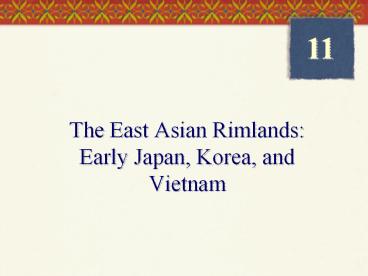11 The East Asian Rimlands: Early Japan, Korea, and Vietnam - PowerPoint PPT Presentation
1 / 17
Title:
11 The East Asian Rimlands: Early Japan, Korea, and Vietnam
Description:
11 The East Asian Rimlands: Early Japan, Korea, and Vietnam Japan and Its Neighbors Japan: Land of the Rising Sun Main islands: Hokkaido, Honshu, Kyushu, and Shikoku ... – PowerPoint PPT presentation
Number of Views:203
Avg rating:3.0/5.0
Title: 11 The East Asian Rimlands: Early Japan, Korea, and Vietnam
1
11
- The East Asian Rimlands Early Japan, Korea, and
Vietnam
2
Japan and Its Neighbors
3
Japan Land of the Rising Sun
- Main islands Hokkaido, Honshu, Kyushu, and
Shikoku - Importance of geography
- Importance of being an island country
- A Gift from the Gods Prehistoric Japan
- Creation myth
- Marriage of Izanagi and Izanami
- Birth of Amaterasu Sun goddess
- Descendant of Amaterasu founded Japan
- Jomon people, 10,000 years ago
- Hunters and gatherers
- Agriculture appeared sometime during the first
millennium B.C.E. - Yayoi culture
- Mixture of Jomon and new arrivals
- First lived on Kyushu and later Honshu
- Tribal society based on clans (uji) in central
Honshu
4
Early Japan
5
Rise of the Japanese State
- Yamoto state
- Two methods to deal with Chinese threat
- Shotoku Taishi (572-622)
- Missions to Tang China to learn about the
centralized kingdom - Emulating the Chinese Model
- Reforms
- Centralized government under a supreme rule
- Merit system for public officials
- Taika reforms continued movement toward
centralized rule - Interest in Buddhism
- Nara Period
- Nara Period (710-784)
- Fujiwara clan married into the ruling Yamato
family - Chinese state model
6
Heian (Kyoto) Period (794-1185)
- Fujiwara clan had the real power, senior member
of the family serves as regent - Decentralized political system
- Shoen (tax exempt) farmland
- Emergence of the samurai (military retainer)
- Bushido warrior code
7
Kamakura Shogunate (1185-1333)
- Minamoto Yoritomo (1142-1199)
- Bakufu (tent government)
- shogun (general)
- Shogunate system
- Mongols
- Khubilai Khan demands tribute, 1266
- Japan invaded twice by the Mongols
- Kamikaze (Divine Wind)
- Kamakura shogunate weakened and overthrown
- Ashikaga shogun
- Power to local landed aristocracy, daimyo
- Onin War (1467-1477)
8
Economic and Social Structures
- Noble control of land, wealth in agriculture
- Commerce slow to develop
- Trade and manufacturing developed more rapidly in
Kamakura period and the Ashikaga shogunate
9
Daily life
- Most were peasants who worked the land owned by
the lord - Under the authority of local officials
- Dispose of harvest as they saw fit after taxes
paid - Genin, landless laborers
- eta, hereditary slaves
- Daily life was similar to others peoples in Asia
- shoen, several villages
- Life was difficult
- Women in Japan
- Had rights in early Japan
- When introduced Buddhism relegated women to a
subordinate position - Nevertheless, played a role in all levels of
society
10
In Search of the Pure Land Religion in Early
Japan
- Shinto
- Kami, nature spirits
- Ancestor worship
- Physical purity and its relationship to women
- Nature and beauty
- State doctrine linked to divinity belief about
emperor and the sacredness of Japan - Buddhism, 6th century B.C.E.
- Jodo, Pure land
- Zen
- Zen teaches ways to achieve Satori, enlightenment
- Zazen, scripture study and self-discipline
11
Sources of Traditional Japanese Culture
- Literature
- Adapted Chinese writing system
- Poetry and prose
- Haiku
- Women prolific writers of prose
- No, drama
- Art and Architecture
- Art
- Search for beauty hand scrolls, screens, other
works - Nature themes dominated search for emotional
response - Kamakura Period (1185-1333)
- Zen Buddhism
- Landscape
- Tea ceremony
12
Japan, China, and Korea, 600-800
13
Japan and the Chinese Model
- Consequences of isolation
- Lack of knowledge form the outside delayed the
process of change - Importance of geography
- Spared destructive invasions
- Decentralized political forces remained dominant
14
Koreas Three Kingdoms
15
Korea Bridge to the East
- Farming began about 2000 B.C.E.
- Chinese influence and rule
- Three Kingdoms (4th-7th centuries)
- Koguryo -- influenced by China, Buddhism, and
Confucianism - Paekche
- Silla -- dominant power
- The Rise of the Koryo Dynasty
- Koryo dynasty
- Social structure
- Buddhism
- Under the Mongols
- Seized in the thirteenth century
- Forced labor for the peasants
- Introduced Chinese ideas and technology
- Yi dynasty, 1392
16
Vietnam The Smaller Dragon
- Irrigated agriculture in area of the Red River
- Conflict with the Qin and Han empires in China
- Trung Sisters Revolt, 39 C.E.
- Chinese regain control
- The Rise of Great Viet
- Overthrow of Chinese rule
- Expansion
- The Chinese Legacy
- Following the Confucian model
- Spread of Buddhism, Daoism, and Confucianism
- Borrowed from Chinese for literature
- Society and Family Life
- Borrowed the Confucian system and the civil
service examination - Peasant masses
- Growing emphasis on male domination
- Strong tradition of heroic women
17
Discussion Questions
- How did geography and climate affect the
development of Japan? - What were the main characteristics of the
political development of early Japan? - How was Japanese daily life like the early life
in China? How was it different? - Trace the development of religion in early Japan.
- What was the relationship between early Japan and
its neighbors in Eastern Asia?































